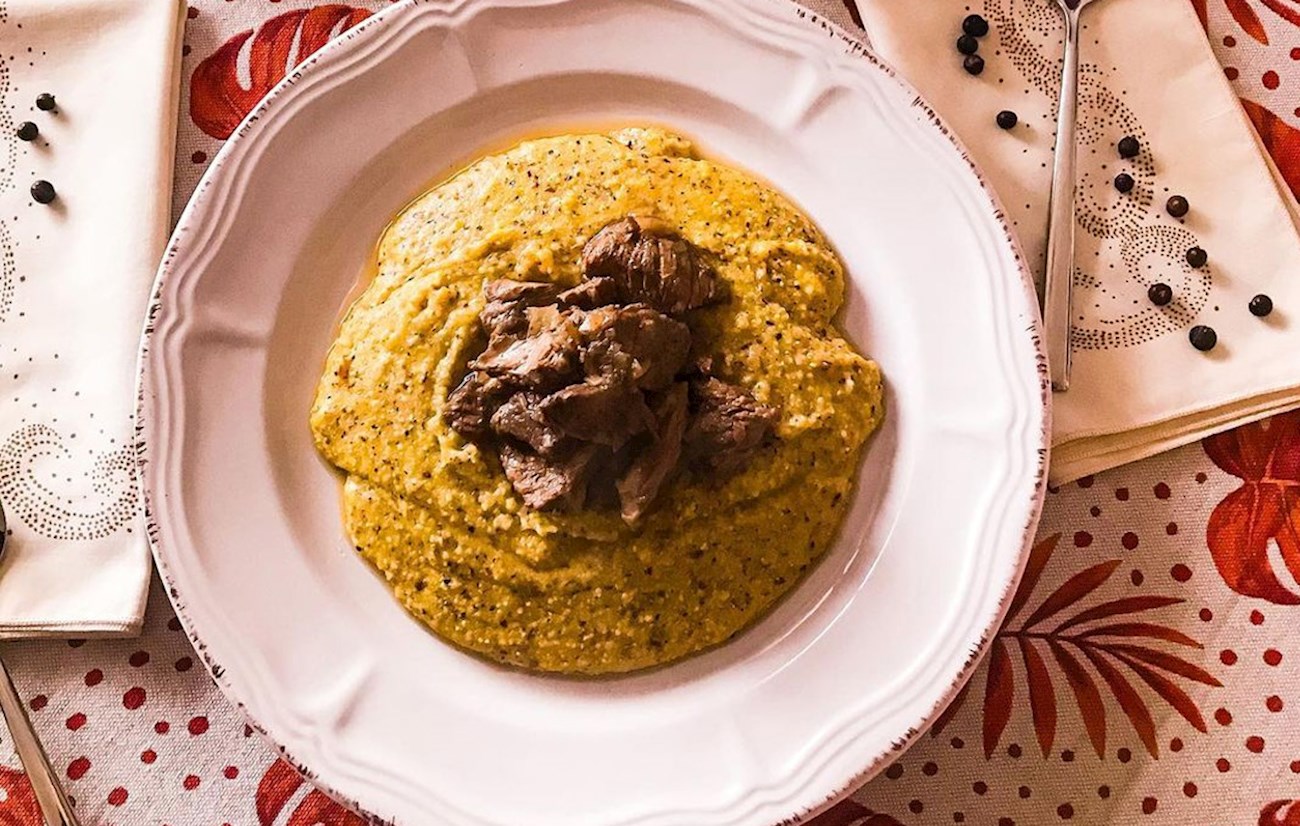MAIN INGREDIENTS
This creamy fondue hails from the Italian Aosta Valley. It is made with a combination of Fontina cheese, egg yolks, milk, and flour. The ingredients are combined and heated until the mixture is well-incorporated and attains its creamy, dense texture.
Aosta-style fondue is sometimes enriched with the addition of white truffle shavings which can be incorporated in the fondue or served on the side. The oldest written mention of the dish dates back to 1854 when a recipe for the truffle based version was published in Trattato di cucina, pasticceria moderna, credenza e relativa confettureria—a cookbook written by the Italian author Giovanni Vialardi.
Carbonade valdostana is a rich Italian beef stew originating from the Aosta valley. It is prepared with a combination of beef (cut into cubes or strips), onions, flour, butter, red wine, and herbs and spices such as cloves, cinnamon, nutmeg, orange peel, and bay leaves.
Once the stew has been prepared, it is traditionally served piping hot over polenta, but it can also be served with garlic mashed potatoes or pappardelle pasta. Originally, the dish was prepared with beef that was preserved in salt, but nowadays regular beef is more often used in the preparation of carbonade.
This widely popular and extremely versatile group of dishes consists of a base of rice and stock. Butter, saffron, and parmesan are some of the ingredients most often combined with the base to make a variety of flavorful risottos. The history of the dish is rife with conflicting theories about its origins, however, it is certain that rice was first introduced to Italy by the Arabs during the Middle Ages.
Since the Mediterranean climate was perfect for growing short-grain rice, huge amounts of it started to be sold - primarily in Venice, Genoa, and the surrounding areas. As rice gained in popularity, it became a staple food of the Po valley, Lombardy, Piedmont, Veneto, and the city of Milan.
VARIATIONS OF Risotto
MAIN INGREDIENTS
Even though tiramisù is actually a fairly recent invention, this dessert of coffee-soaked ladyfingers layered with mascarpone cream enjoys an iconic status among Italian desserts. Its name stems from the phrase tirami sù, an Italian expression which literally means pick me up, a reference to the uplifting effects of sugar, liquor, and coffee.
The origins of tiramisù are heavily disputed between Veneto and Friuli-Venezia Giulia regions, but it is often suggested that the first was made in Veneto in the early 1960s. The earliest documented recipe for tiramisù (interestingly, without alcohol!) was printed in the 1981 spring edition of Vin Veneto magazine in an article on coffee-based desserts by Giuseppe Maffioli, a renowned food critic and member of the Italian Academy of Cuisine.
Tortelli is a variety of Italian stuffed pasta prepared in a few shapes: square, semicircular, or rounded and twisted. The pasta is popular throughout Italy, especially in Tuscany, Lombardy, and Emilia-Romagna. One of the most famous dishes featuring this pasta variety is called tortelli con zucca, where tortelli are filled with pumpkin, crushed cookies, and parmesan cheese.
The dish is then topped with more cheese and a sauce consisting of butter and sage.
VARIATIONS OF Tortelli
This Italian dessert consists of cheese or cream and fruit in a crusty pastry, similar to fruit-filled pies. The most commonly-used fruit in crostata are cherries, berries, apricots, or peaches. It can be prepared as an open-faced dessert or covered with a top crust, usually in the form of a lattice.
Its name is derived from the Latin crustata, which means crust. The earliest mentions of crostata in print can be found in cookbooks such as Libro de Arte Coquinaria by Martino da Como and Cuoco Napolitano, both from the 15th century.
Risotto ai funghi, or mushroom risotto, is a classic Italian dish celebrated for its creamy texture and rich, earthy flavors.
The dish begins with sautéing Arborio or Carnaroli rice in butter to lightly toast the grains. This is followed by adding finely chopped onions or shallots until they are translucent. Hot stock, typically chicken or vegetable, is then gradually added to the rice.
VARIATIONS OF Risotto ai funghi
MAIN INGREDIENTS
Risotto ai funghi porcini is a traditional type of risotto prepared with porcini mushrooms as the key ingredient. Apart from fresh or dried porcini, the dish also contains carnaroli or arborio rice, olive oil, butter, shallots, white wine, meat stock, grated Parmigiano-Reggiano, salt, and pepper.
The onion is sautéed in butter and olive oil, followed by the mushrooms, rice, and white wine. The stock is added as the risotto is cooking. Near the end of cooking, a knob of butter is added to the pan, while grated cheese can be mixed into the risotto in the end or it can be served at the table so that each person can put the desired amount of cheese on their risotto.
Tortelli cremaschi is a traditional pasta dish originating from Crema. The dough for the tortelli is made from white flour, semolina flour, eggs, olive oil, and salt. Once prepared, it's rolled and filled with a combination of cocoa amaretti (amaretti Gallina), mostaccino biscuit with spices, raisins, Marsala or dry anise liquor, candied lemon, mint, and grated Grana Padano cheese.
The tortelli are pinched by hand and sealed, then boiled in water. They're usually served in a butter and sage sauce.
Torta Bertolina is a simple, golden-brown, round cake made with fragrant uva fragola, also known as Concord or strawberry grapes, as the main ingredient. Its exact origins are unknown, but nowadays it is usually associated with the northern Italian province of Cremona, especially the city of Crema.
Since it is usually homemade, there are many variations of the recipe, but the main characteristics always remain unchanged: sweet golden crust spotted with dark purple grapes and the unmistakable scent of sweet uva fragola.









